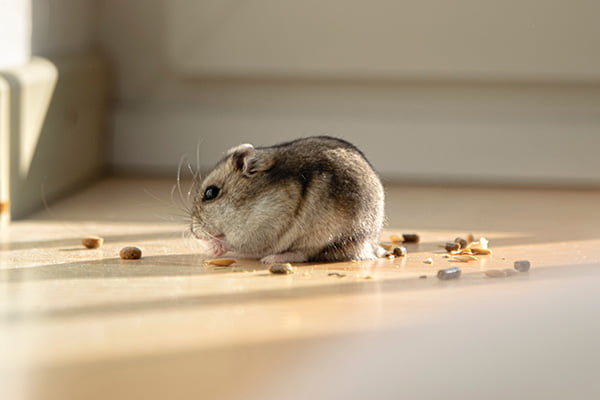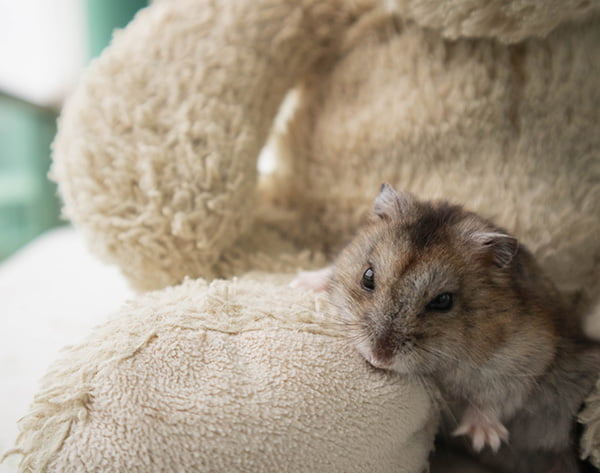Chinese hamsters are a great pet for first-time pet owners and current hamster owners and lovers alike. These hamsters have mild manners and are super easy to care for. As small animals, their cages don't take up much space, and Chinese hamsters are generally quiet and unobtrusive.
So, how do you care for a Chinese hamster, and is it your next pet?
Name And Origin of Chinese Hamsters
The Chinese hamster is a small domesticated hamster that is native to the deserts of China and Mongolia. These hamsters are also called Chinese Striped Hamsters or Chinese Dwarf Hamsters.
Despite their small size, Chinese hamsters are not dwarf hamsters. Even though the Chinese hamster is small compared to other pet hamster breeds, such as the Syrian hamsters, they are not a dwarf breed. They are about half the size of a Syrian hamster and slightly longer than Russian Dwarf Hamsters.

Source: Unsplash
Appearance and Size
Chinese hamsters are quite small. The dwarf hamsters grow between 3-5 inches long and only weigh 1-2 ounces full grown. They reach maturity at about two months of age. Chinese dwarf hamsters also have longer tails than most other hamster breeds.
A Chinese hamster has a brown coat with a single black stripe running down its back, and its bellies are usually a lighter shade of brown or tan.
Life Expectancy
Chinese hamsters live for 2 or 3 years.
Housing
One of the reasons Chinese hamsters make a great pet is that they do not take up a whole lot of space for their housing. Housing options are usually either a cage with a plastic base and a wire frame top or a glass tank.
The first cage option is best for ventilation and can be easier to clean, but you must ensure that the wireframe is tight enough so your hamster can't squeeze through and escape. The minimum cage size should be 2 feet by 1 foot and at least 1 foot high. Bigger is always better, so if you can afford a bigger cage and have the space for it, you should get a larger cage.
The cage needs to be completely cleaned once a week, the substrate replaced, and the base wiped clean with a pet-safe cleaner.
Adding toys and other objects for your hamster to play with and hide in will greatly increase your hamster's quality of life. Hamster wheels can help keep your hamster fit and happy. Tunnels, hideouts, cardboard tubes, and wooden chew toys are a great way to fill out your hamster's space.
Behavior & Temperament
Chinese hamsters are generally docile and mild-natured pets. They are easy to tame, and if they are handled often and gently as young babies, they will be less skittish. A tamed Chinese hamster may love to cling to its owner's finger like a harvest mouse on a corn stalk. Untamed Chinese hamsters can be more nervous and, as such, they may resort to biting.
Hamsters are nocturnal creatures, so it is normal to notice them sleeping during the day and hear them out and about at night. It would be best if you were careful not to wake a sleeping Chinese hamster since this can upset them and make them nippier.
Chinese hamsters are very small and fast animals, so anytime you handle one, be sure that you are near the ground and know how to hold them safely. A fall from even only a few feet can result in serious injury.
Chinese hamsters do well housed by themselves or in same-sex pairs, and they may become territorial even in same-sex pairs, so it is recommended that you get littermates if you want to house more than one Chinese hamster in one cage.
A female Chinese hamster can become extremely aggressive during pregnancy, and it's best to remove a male companion during this time.
Feeding a Chinese Dwarf Hamster
Chinese hamsters are pretty easy to feed as their basic hamster food can be found in most pet stores. In the wild Chinese hamsters forage a variety of grains, nuts, vegetation, and insects, and most hamster pet food blends add similar ingredients to balance out a hamster's diet.
For additional supplementation, you can provide fruits, veggies, and Timothy hay, though these should never exceed more than 10-20% of your Hamster's diet.
Use a ceramic bowl both for the pelleted blend and for any fresh food. Hamsters are grazing animals, so do not be concerned if your hamster doesn't have a sit-down meal. Leave food out and available for 24 hours before throwing it out or switching to avoid spoilage.
Water
Always have fresh and clean water available to your Chinese hamster. A bottle is ideal as it is less messy and more sanitary, but you may need to have both a bottle and a bowl if your Chinese dwarf hamster has to transition.
Substrate
Hamster substrate can be found at any pet store, and you should get paper-based substrate or aspen shavings. Cedar chips are not recommended, as hamsters can be sensitive to cedar.
You should spread 1-2 inches of substrate in the base of your hamster's cage to allow for burrowing and nesting. Hamsters generally designate a spot somewhere in their cage to use as a bathroom, so you may need to remove soiled or wet substrates as needed to maintain cleanliness. Also, check for any stored or stashed food, particularly fresh food, that could spoil, and remove it.

Source: Unsplash
Grooming
Chinese hamsters are generally very clean pets to have, and they are diligent about cleaning their fur and do not need to be bathed. If your hamster ever gets unusually dirty and has trouble cleaning itself, you can gently wipe it clean with a clean, damp cloth. Always be gentle as your hamster is fragile, and don't leave it soaking wet as this could lead to a number of illnesses.
Gender Identification
Given the very small size, sexing your Chinese hamster could be quite challenging. Additionally, it may upset them to be turned over, and you may accidentally harm them. Taking your hamster to a vet to be properly sexed is the recommended way, as it is the safest and most sure way to confirm your hamster's gender.
The most basic way you could identify your hamster's gender at home is by visually examining the area between their back legs. Female Chinese hamsters are usually smooth here, whereas males will develop a bulge.
Breeding
Chinese hamsters sexually mature at around 4-8 weeks old, but should not male and female hamsters should not be introduced until they are four months old.
The gestation for a Chinese hamster is 20-21 days. The litter size ranges from 4-5, and they typically get weaned off at 21 days.
Common Health and Behavior Problems
Chinese hamsters are fragile creatures physically and can be hurt by even shortfalls. However, they are hardy pets when it comes to diseases and hereditary issues.
Wet Tail
Wet Tail is diarrhea that comes as a result of excessive stress or unsanitary living conditions. This diarrhea can lead to bacterial infections, which can then be transmitted to other hamsters in the cage. A hamster with Wet Tail will be lethargic and have a reduced appetite, and this disease is fatal if not treated immediately.
Lung Disorders
Lung disorders can come about for a number of reasons and are marked by symptoms such as wheezing, nasal discharge, sneezing, and lethargy. It is a serious condition that requires immediate attention once it is spotted, so take your Chinese striped hamster immediately.
Overgrown Teeth
Chinese dwarf hamsters have open-rooted teeth, which means they need to be chewing to keep the teeth from overgrowing constantly. Having chew toys can greatly aid in ensuring teeth stay trimmed.
However, if the teeth are allowed to overgrow, they will eventually interfere with a hamster's eating ability, resulting in weight loss. Often the only symptom you may notice of dental issues is that your hamster is not eating as much, so monitoring your hamster's eating habits can help you catch this early.
A vet can trim your Chinese hamster's teeth and discuss ways to encourage your hamster to chew more to keep its teeth in shape.
